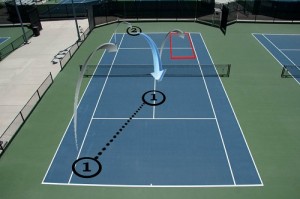If you are hoping to do some traveling, it’s important for any tennis fan to know what to expect from the tennis scene in that country. Specifically, what kind of surface can I expect to be the most popular in that particular part of the world. Each type of court, whether hard, clay, or grass, have their own special characteristics players have to adjust to when playing on them.
So if you ever have aspirations to play on clay courts overlooking the Mediterranean or some sole melting hard courts in the Australian heat, read on. Today we explore the ins and outs of the hard court.
Hard Courts
Where to find them: United States, Australia, Asia
Hard court, the surface played on at the Australian Open and US Open is a relatively fast surface. Players with big serves and groundstrokes such as Sampras, Roddick, Isner and the majority of up and coming players, have crafted their games around this surface. The surface It does not take away from the speed of the ball and in turn there not usually as many long rallies. Players with a great reaction and response time benefit from the surface and are usually able to use their opponent’s hitting pace in an effective way, often hitting it back even more aggressively. Considering how fast the surface is, a heavy flat serve and groundstrokes (don’t overuse topsin) are key to winning a match on hard court.
What is my strategy on this surface?
– Returning a serve down the line or crosscourt
When possible, return the serve down the line (or even cross court) and you immediately put your opponent in a defensive position. An aggressive return forces your opponent to instantly move, making it even harder for them to hit an effective shot back.
 Drill: Player 1 serves from the baseline and Player 2 stands in the court (about 6 feets away from the baseline). Player 2 has to react quickly, take the ball on the rise and try to hit it cross court as well as down the line into the marked area. Player 2 starts hitting the ball crosscourt and the next one down, alternating.
Drill: Player 1 serves from the baseline and Player 2 stands in the court (about 6 feets away from the baseline). Player 2 has to react quickly, take the ball on the rise and try to hit it cross court as well as down the line into the marked area. Player 2 starts hitting the ball crosscourt and the next one down, alternating.
– Position yourself close to the baseline
If you want to win a match on hard court, you need to keep up with the aggressive play. By positioning yourself close to the baseline, you can hit the ball very early, that is right after the ball touches the ground and rises again. That makes it easier to hit low balls and speed up the game.
– Shorten the game
The pace of each ball forces you to try and end rallies sooner. If you fail to do so, your opponent is going to attack you with a winner before long. Utilizing a backhand slice, you can give yourself time to relocate on the court, by either moving back to your initial position or by approaching the net.
 Drill: Player 1 plays a backhand slice down the line and approaches the net. Player 2 hits the ball back to the forehand side of Player 1 who tries to hit a volley in the free corner (place marks at the area). After the volley the play continues until one player makes a mistake.
Drill: Player 1 plays a backhand slice down the line and approaches the net. Player 2 hits the ball back to the forehand side of Player 1 who tries to hit a volley in the free corner (place marks at the area). After the volley the play continues until one player makes a mistake.
– Serve and Volley
Shortening the overall game and the length of rallies can be achieved by using the “Serve and Volley” strategy. Once the staple of the game, serving and volleying is an extremely effective, but dying art. Ideally, hit a fast flat serve and follow it to the net right after hitting the serve. If your serve proves difficult to return you will easily be able to cut off the angle and finish the point quickly with a well placed volley.
 Drill: Player 1 tries to serve either up the “T” or to the outside and then approaches to the net to finish the point. Player 2 on the other side tries to hit a passing shot. The game continues with Player 1 at the net until one player miss a shot.
Drill: Player 1 tries to serve either up the “T” or to the outside and then approaches to the net to finish the point. Player 2 on the other side tries to hit a passing shot. The game continues with Player 1 at the net until one player miss a shot.